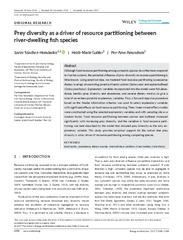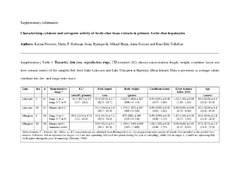Artikler, rapporter og annet (arktisk og marin biologi): Nye registreringer
Viser treff 1181-1200 av 1643
-
Prey diversity as a driver of resource partitioning between river-dwelling fish species
(Journal article; Tidsskriftartikkel; Peer reviewed, 2017-02-26)Although food resource partitioning among sympatric species has often been explored in riverine systems, the potential influence of prey diversity on resource partitioning is little known. Using empirical data, we modeled food resource partitioning (assessed as dietary overlap) of coexisting juvenile Atlantic salmon (Salmo salar) and alpine bullhead (Cottus poecilopus). Explanatory variables ... -
Cold acclimation in warmer extended autumns impairs freezing tolerance of perennial ryegrass (Lolium perenne) and timothy (Phleum pratense)
(Journal article; Tidsskriftartikkel; Peer reviewed, 2017-02-01)The effect of variable autumn temperatures in combination with decreasing irradiance and daylength on photosynthesis, growth cessation and freezing tolerance was investigated in northern- and southern3 adapted populations of perennial ryegrass (Lolium perenne L.) and timothy (Phleum pratense L.) intended for use in regions at northern high latitudes. Plants were subjected to three different acclimation ... -
A simplified method to estimate Diphyllobothrium spp. infection in salmonids
(Journal article; Tidsskriftartikkel; Peer reviewed, 2016-10-13)Some fish parasites constitute severe management problems as they may cause mortality of their fish host or are important zoonoses of humans. Parasite assessments are therefore critical to keep track of infections. If conventional sampling techniques can be simplified, parasite assessments might be easier to obtain, less time-consuming and more extensive. In this study, we compare the ... -
Variation in functional trait composition of benthic invertebrates across depths and seasons in a subarctic lake
(Journal article; Tidsskriftartikkel, 2016-07-01)Benthic invertebrate communities play a fundamental role in lake ecosystems, and the understanding of how those benthic communities are structured, particularly in terms of the identity and spatiotemporal distribution of their functional traits, is key to our understanding of how lake ecosystems work. In Takvatn, a subarctic lake in northern Norway, we identified the taxonomic and functional identity ... -
Characterizing cytotoxic and estrogenic activity of Arctic char tissue extracts in primary Arctic char hepatocytes
(Journal article; Tidsskriftartikkel; Peer reviewed, 2017-09-01)Contaminants from various anthropogenic activities are detected in the Arctic due to long-range atmospheric transport, ocean currents, and living organisms such as migrating fish or seabirds. Although levels of persistent organic pollutants (POPs) in Arctic fish are generally low, local hot spots of contamination were found in freshwater systems such as Lake Ellasjøen at Bjørnøya (Bear Island, ... -
Knowledge and practices of brucellosis among high-risk groups in Bahr El Ghazal Region, South Sudan
(Journal article; Tidsskriftartikkel; Peer reviewed, 2017-08-03)<b>Background:</b> Brucellosis is the most common zoonotic infections in pastoral settings. Lack of knowledge about the disease may cause devastating out come to the patients, thus sustained it in such communities. This study assessed knowledge and practices among high-risk groups in Bahr el Ghazal region, South Sudan. <br><b>Methods:</b> Across sectional survey involving abattoir workers, febrile ... -
Molecular analyses reveal high cryptic diversity of trematodes in a sub-Arctic lake
(Journal article; Tidsskriftartikkel; Peer reviewed, 2017-03-14)To identify trematode diversity and life-cycles in the sub-Arctic Lake Takvatn, Norway, we characterised 120 trematode isolates from mollusc first intermediate hosts, metacercariae from second intermediate host fishes and invertebrates, and adults from fish and invertebrate definitive hosts, using molecular techniques. Phylogenies based on nuclear and/or mtDNA revealed high species richness (24 ... -
Relationship between marine growth and sea survival of two anadromous salmonid fish species
(Journal article; Tidsskriftartikkel; Peer reviewed, 2017-06-12)Résumé : L’étude fait état de preuves empiriques appuyant le paradigme de « croissance–survie » chez les phases marines de l’omble chevalier (Salvelinus alpinus) et de la truite de mer (Salmo trutta). Ce paradigme postule que les individus plus grands ou a` croissance plus rapide sont plus susceptibles de survivre que leurs conspécifiques plus petits ou a` croissance plus lente. Nous avons utilisé ... -
Gatekeepers to the effects of climate warming? Niche construction restricts plant community changes along a temperature gradient
(Journal article; Tidsskriftartikkel; Peer reviewed, 2017-06-20)Organisms that modify the environment (niche constructors) are likely candidates to mediate the effects of climate warming. Here we assess tundra plant community changes along a temperature gradient and how these are modified in the presence of the common allelopathic dwarf shrub Empetrum nigrum and the large herbivore Rangifer tarandus. 2 We developed a structural equation model based on data ... -
Carbon stocks and fluxes in the high latitudes: Using site-level data to evaluate Earth system models
(Journal article; Tidsskriftartikkel; Peer reviewed, 2017-11-17)It is important that climate models can accurately simulate the terrestrial carbon cycle in the Arctic due to the large and potentially labile carbon stocks found in permafrost-affected environments, which can lead to a positive climate feedback, along with the possibility of future carbon sinks from northward expansion of vegetation under climate warming. Here we evaluate the simulation of tundra ... -
Rangifer management controls a climate-sensitive tundra state transition
(Journal article; Tidsskriftartikkel; Peer reviewed, 2017-09-04)Rangifer (caribou/reindeer) management has been suggested to mitigate the temperature- driven transition of Arctic tundra into a shrubland state, yet how this happens is uncertain. Here we study this much focused ecosystem state transition in riparian areas, where palatable willows (Salix) are dominant tall shrubs and highly responsive to climate change. For the state transition to take place, ... -
Genetics redraws pelagic biogeography of Calanus
(Journal article; Tidsskriftartikkel; Peer reviewed, 2017-12-20)Planktonic copepods of the genus Calanus play a central role in North Atlantic/Arctic marine food webs. Here, using molecular markers, we redrew the distributional ranges of Calanus species inhabiting the North Atlantic and Arctic Oceans and revealed much wider and more broadly overlapping distributions than previously described. The Arctic shelf species, C. glacialis, dominated the zooplankton ... -
Zooplankton excretion metabolites stimulate Southern Ocean phytoplankton growth
(Journal article; Tidsskriftartikkel; Peer reviewed, 2017-04-24)Warming over Antarctica is leading to changes in the zooplankton communities inhabiting the Southern Ocean. It has been observed that zooplankton not only regulates phytoplankton through grazing, but also through the recycling of nutrients that are essential for phytoplankton growth. In this way, the effects of warming on zooplankton populations will change the amount or proportion at which recycled ... -
The use of the nest for parental roosting and thermal consequences of the nest for nestlings and parents
(Journal article; Tidsskriftartikkel; Peer reviewed, 2017-11-07)Abstract<br> At temperate latitudes, altricial birds and their nestlings need to handle night temperatures well below thermoneutrality during the breeding season. Thus, energy costs of thermoregulation might constrain nestling growth, and low nocturnal temperatures might require resources that parents could otherwise have invested into nestlings during the day. To manipulate parental work rate, we ... -
Circumpolar dynamics of a marine top-predator track ocean warming rates.
(Journal article; Tidsskriftartikkel; Peer reviewed, 2017-04-07)Global warming is a nonlinear process, and temperature may increase in a stepwise manner. Periods of abrupt warming can trigger persistent changes in the state of ecosystems, also called regime shifts. The responses of organisms to abrupt warming and associated regime shifts can be unlike responses to periods of slow or moderate change. Understanding of nonlinearity in the biological responses to ... -
Elucidating the Behavior of Cyclic Volatile Methylsiloxanes in a Subarctic Freshwater Food Web: A Modeled and Measured Approach
(Journal article; Tidsskriftartikkel; Peer reviewed, 2017-10-05)Cyclic volatile methylsiloxanes (cVMS) are used in personal care products and emitted to aquatic environments through wastewater effluents, and their bioaccumulation potential is debated. Here, a new bentho-pelagic version of the ACC-HUMAN model was evaluated for polychlorinated biphenyls (PCBs) and applied to cVMS in combination with measurements to explore their bioaccumulation behavior in a ... -
Not only mosses: lemming winter diets as described by DNA metabarcoding
(Journal article; Tidsskriftartikkel; Peer reviewed, 2017-04-01)The temporal dynamics of most tundra food webs are shaped by the cyclic population dynamics of lemmings. While processes during winter may be behind the recent disruptions of lemming cycles, lemming winter ecology is poorly known. We present here the first DNA metabarcoding data on the winter diet of Norwegian lemmings (Lemmus lemmus), based on feces collected after a winter of population ... -
Polyunsaturated fatty acids in freshwater fishes increase with total lipids irrespective of feeding sources and trophic position
(Journal article; Tidsskriftartikkel; Peer reviewed, 2017-04-03)Trophic transfer and retention of dietary compounds are vital for somatic development, reproduction, and survival of aquatic consumers. In this field study, stable carbon and nitrogen isotopes, and fatty acids (FA) contents in invertebrates and fishes of pre-alpine Lake Lunz, Austria, were used to (1) identify the resource use and trophic level of Arctic charr (Salvelinus alpinus), pike (Esox lucius), ... -
Allometric trajectories of body and head morphology in three sympatric Arctic charr (Salvelinus alpinus (L.)) morphs
(Journal article; Tidsskriftartikkel; Peer reviewed, 2017-08-08)A study of body and head development in three sympatric reproductively isolated Arctic charr (Salvelinus alpinus (L.)) morphs from a subarctic lake (Skogsfjordvatn, northern Norway) revealed allometric trajectories that resulted in morphological differences. The three morphs were ecologically assigned to a littoral omnivore, a profundal benthivore and a profundal piscivore, and this was confirmed ... -
The trade-off between fecundity and egg size in a polymorphic population of Arctic charr (Salvelinus alpinus (L.)) in Skogsfjordvatn, subarctic Norway
(Journal article; Tidsskriftartikkel; Peer reviewed, 2017-02-26)Reproductive traits differ between intralacustrine Arctic charr morphs. Here, we ex - amine three sympatric lacustrine Arctic charr morphs with respect to fecundity, egg size and spawning time/site to assess reproductive investments and trade- offs, and possible fitness consequences. The littoral omnivore morph (LO- morph) utilizes the upper water for feeding and reproduction and spawn ...


 English
English norsk
norsk


















